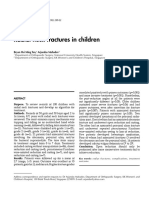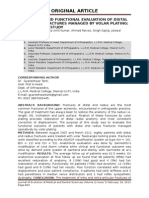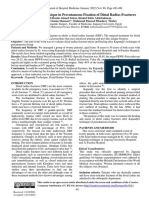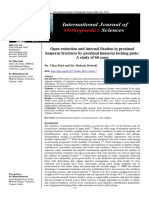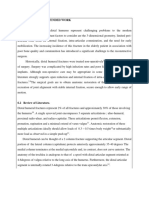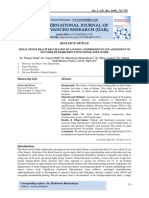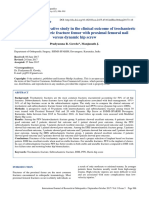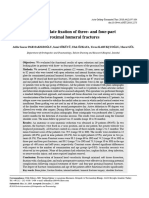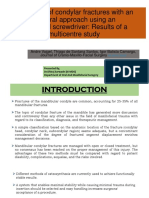Percutaneaus Kirschner-Wire Fixation For Displaced Distal Forearm Fractures in Children
Percutaneaus Kirschner-Wire Fixation For Displaced Distal Forearm Fractures in Children
Uploaded by
naluphmickeyCopyright:
Available Formats
Percutaneaus Kirschner-Wire Fixation For Displaced Distal Forearm Fractures in Children
Percutaneaus Kirschner-Wire Fixation For Displaced Distal Forearm Fractures in Children
Uploaded by
naluphmickeyOriginal Title
Copyright
Available Formats
Share this document
Did you find this document useful?
Is this content inappropriate?
Copyright:
Available Formats
Percutaneaus Kirschner-Wire Fixation For Displaced Distal Forearm Fractures in Children
Percutaneaus Kirschner-Wire Fixation For Displaced Distal Forearm Fractures in Children
Uploaded by
naluphmickeyCopyright:
Available Formats
Med. J. Cairo Univ., Vol. 78, No. 2, September: 51 -55, 2010 www.medicaljournalofcairouniversity.
com
Percutaneaus Kirschner-Wire Fixation for Displaced Distal Forearm Fractures in Children
EMAD G.K. EL BANNA, M.D.; AMR M.S. ABDEL MEGUID, M.D. and ATEF M. MORSY, M.D.
The Department of Orthopaedics, Faculty of Medicine, Bani Suef University.
Abstract
Forearm Fractures are common injuries in children, translation more than half of the diameter of bone at the fracture site, is the commonest cause for the poor results. The aim of this study is to evaluate the efficacy of Percutaneaus KirschnerWire fixation done for the management of the displaced distal 1/4 (one fourth) fracture of the forearm in children. Material and Methods: Twenty cases were managed (18 males, 2 females). Four with ulnar and radial fractures, sixteen with isolated distal forearm fractures. Management was done by closed reduction and percutaneaus K-wire fixation by the aid of C-Arm imaging control. The average age was eight years ranged from 5 to 12 years. The commonest mechanism of injury is fall from bicycle during playing (50%). These cases were closed fractures, except in one case where the fracture was gustillo I injury (puncture wound). Results: The minimum follow-up duration was 10 months, during which evaluation was done, performed by clinical and radiological examinations. More than 80% of cases had excellent satisfactory results. Conclusion: We concluded that, Percutaneaus KirschnerWire Fixation for Displaced Distal Forearm Fractures in Children, is a good reliable method of treatment which yields satisfactory results. Key Words: K-wire fixation Forearm fractures.
Commonest causes of limitation of forearm rotation are angular deformity and mal-alignment [3]. However Nilson et al., have shown that loss of rotation is not related to angular deformity and may persist despite full remodeling of the fractures [4]. Hughson recommended [1] that fractures in patients over 14 years of age should be treated as adults, but those children under 10 years old with distal forearm 1/4 fracture, 30-40 angulation was accepted. Daur Wella [2] suggested that no more than 10 of angulation should be allowed in children over the age of 10 years old. Generally speaking the younger the age, the more distal the fracture and less angulation, the better results [4] . Proctor reported that the redisplacement is related to the position of the forearm in the cast especially with loose casts [5] . Proctor et al., identified two factors which increase the chance of redisplacement of the forearm fractures in children, severe displacement and failure to achieve good alignment [5] . Mani et al., predicted failure rate of 60% if radial fracture is displaced more than 60% half the diameter of the bone, and 60% after complete displacement [3] . The aim of this study is to evaluate the value of the use of K-wire for the management of severely displaced distal forearm fractures in children. Material and Methods This study group included 20 patients, 18 males & 2 females, age ranged from 4 to 12 years. Fifteen patients was 10 or above 10 years old (75%), and five patients were less than 5 years old (25%). The right forearm was involved in 12 patients and the left one was involved in 8 patients. According to the fracture site, 90% of cases represented with the injury in the distal 1/4 of the radius. Associated ulnar fractures were present in 4 cases, about 20%.
Introduction DISTAL forearm fractures can be considered as the commonest skeletal injuries in children. Although anatomic reduction is not always necessary because of the remodeling capacity in children, reduction and internal fixation should be performed if closed reduction is not successful [1] . Recently, most studies have shown poor end result in 35% of cases, particularly with regard to limitation of forearm rotation [2] .
Correspondence to: Dr. Amr M.S. Abdel Meguid The Department of Orthopaedics, Faculty of Medicine, Bani Suef University.
51
52
Percutaneaus Kirschner-Wire Fixation for Displaced Distal Forearm Fractures
All Surgeries were performed on the day of admission, and the postoperative hospital stay ranged from 12 to 24 hours. All cases were done Between December 2008 and October 2009. 18 patients were followed-up 1 year postoperatively, 2 patients were evaluated for about 8 months. Isolated distal 1/4 forearm fractures was reported in 16 cases. While the rest 4 cases fractures were associated with distal ulnar fracture. All cases were done in Bani-Suef University Hospitals, managed with Percutaneus K-wire fixation by the aid of C-arm, X-rays and application of posterior slab. Dislocation, epiphyseal injuries and pathological fractures were excluded. Age of patients ranged from 4 to 12 years (mean age was 8 years), right forearm was included 12 cases (60%). The fractures were caused by an unspecified fall, a fall during sport activities [7] , a bicycle accident [10] , and motor vehicle accident [3] . The fracture was open (Gustillo-G1 puncture type) in only one case. No associated injuries were present. X-rays were done to assess and evaluate the site of the fracture, whether involving the distal 1/4 or between 1/4 and 1/3 of the total length of the radius, degree of angulations, translation, and the presence of distal ulnar fracture. Degree of translation of the radius at the site of fracture was graded as follows: Grade I: No translation. Grade II: Translation less than the diameter of the bone.
Grade III: Translation greater than half the diameter of the bone. Grade VI: Complete translation with no end-toend contact [10] . In our study 8 cases laid in group 4 translation of the distal forearm, 7 patients with grade 3, and 5 in group 2. Surgery was indicated in group 3 and 4. Cases with angualtion greater than 15 degrees and grade 2 patients with displacement in any direction with angulation greater than 10 degrees, were also indicated for surgery. Technique: The operation was done under general anesthesia and C-Arm image control, without tourniquet except in cases associated with ulnar fractures. Accepted reduction was defined as; at least there were 80% or more bony contact across the fracture site with no angulation in patients aged 10 years old or more, and no more than 10 degree angulation in patients less than 10 years old. Rotation was corrected and assessed before fixation by checking the width and shape of the bone fragments and after fixation, done by limited motion forearm rotation. There is no need for fixation of the distal ulnar epiphyseal injuries or the minimally displaced fractures. All cases were managed by retrograde K. wire fixation; a 1.8mm K-wire was inserted from the radial styloid between the first and second extensor compartments to avoid tendon injury. In proximal fractures the Kwires were inserted in the metaphyseal part of the bone, where in distal fractures the K-wires were inserted through the epiphysis.
Fig. (1): PRE-OP A-P X-Ray showing fracture distal radius.
Fig. (2): Post-op A-P X-Ray after reduction & K-wires insertion.
Emad G.K. El Banna, et al.
53
After fracture fixation, the K-wire tip should be directed towards the opposite cortex of the radius, passed through the medulla for at least 2cm beyond the fracture site. External immobilization was done, by placing a posterior slab to the elbow, with the forearm and wrist in neutral position, in patients younger than 10 years. Where, older children were immobilized by a well molded cast. Child was encouraged to move his fingers fully, in order to strengthen the wrist grip. After cast and posterior slab removal, patients were asked to move his wrist, forearm and elbow. K-wires were removed in the out-patient clinic without anesthesia after 6 weeks. All patients were followed-up clinically and radiologically after Kwire removal, for about 12 months. Evaluations of the patients include wrist and elbow movements, presence of any clinical deformity or persisting pain. Healing and residual angulations were assessed by radiograph examinations. Angulations of the radius and ulna were measured on anteroposterior (AP) and lateral radiographs of the forearm at most recent follow-up. To evaluate the distal radio-ulnar relation accurately, AP wrist radiographs of the injured and uninjured sides were taken in standard manner by positioning the elbow 90 flexion, while the shoulder was abducted 90 and flexed forward. Criteria of poor results can be summarized as follows: Loss of forearm rotation more than 20 degrees. Loss of wrist movement more than 20 degrees. Persisting pain. Clinical deformity, or residual angulation greater than 15 degrees in the frontal and lateral planes. Results The operative time ranged from 20 to 40 minutes, duration of surgery was related to the severity of displacement of the fracture, and presence of associated ulnar fracture. None of our patients required open reduction. All cases healed within 6 to 8 weeks, (callus formation appeared on radiographs in about 6 weeks; the range was from 3 to 8 weeks. No neurovascular injuries were reported in this series. No irritation was reported from the inserted K-wires. Two patients (10%) had a superficial infection, which was successfully treated with oral antibiotics and every other day dressing changes for 2 weeks.
Eighty percent of cases had excellent results. Four cases developed poor results. Two patients had residual angulations, patients with angulations, were aged about 10 years and reduction was not anatomic on the early postoperative radiographs. These cases that healed with some degree of angulations (about 15 degree), had restricted range of motion in forearm rotation together with limited forearm supination (about 20 degree). Insignificant pain was present in two cases, which resolve spontaneously; the first case was 11 years old, presented late after trial of conservative treatment with dorsal tilt of 30 degree and radial tilt of 15 degree. The second case was 5 years old, who had limited supination (about 20 degree), due to wrist pain, which improved with time. Elbow and wrist range of motion were complete in all patients. Discussion The use of percutaneous K-wire for fixation of forearm fractures in children has been shown to be successful with fewer complications [6,7,8] . This method provides reasonable stability on the frontal and saggital plane; however, few reports exist on the effect on the wrist. Conservative treatment for displaced distal forearm fractures in children is possible but reduction must be perfect and the cast must be well moulded. The risk factors for poor outcome include children older than 10 years with fracture translation more than half the diameter of the bone at the fracture site or angulation more than 20 degrees. Failure to achieve good reduction, repeated manipulation and presence of associated ulnar fractures are also considered as important risk factors [9] . Several studies recommended use of percutaneous K-wires directly for the stabilization of the good reduction, especially in the high risk groups and open injuries [10] . Percutaneous K-wires fixation are widely used for treating children's fractures such as supracondylar fracture of the humerus, and the forearm shaft fractures [10] . Complications of the retrograde technique fixation include irritation of extensor tendons, skin irritation, pin tract infection, and the less common partial premature physeal closure [9] . In our study we did not report any case of premature physeal closure, also this complication has been rarely reported. One of the foremost concerns in the management of forearm fractures in children is loss of
54
Percutaneaus Kirschner-Wire Fixation for Displaced Distal Forearm Fractures
forearm rotation. Noonan and price [10] had reported that good results are based on restoration of adequate pronation and supination. Tarr et al., reported that greater loss of motion of the forearm occurred in mid-third deformities [11] . The other reason for the loss of rotation is soft tissue injury. Verstreken et al., report that to prevent refracture, pin removal should not be performed before 2 months postoperatively. This raises the concerns about leaving the end of the K-wire outside the skin [12] . Shoemaker et al., reported 2 infections in cases where the K-wires were left outside the skin. In our study, two patients (10%) had a superficial infection, which was successfully treated with oral antibiotics and every other day dressing changes for 2 weeks. Few reports in the literature discuss the changes on the wrist after forearm fractures [14,15] . Trousdale and Linscheid reported that if a malunited fracture of the radius is left untreated for a prolonged period, degenerative joint disease of the proximal radioulnar joint can develop because of eccentric load to the joint [16] . Creasman et al., reported that fractures healed with shortening of >3mm at the distal radioulnar joint often had unsatisfactory outcomes. Because this technique does not provide rigid fracture fixation, some changes can be expected at the distal radioulnar joint [17] . The changes in the distal radioulnar joint can be related to the epiphyseal damage that occurred during initial trauma of distal radial physis. A fall on an outstretched hand is the most frequent mechanism of the radial and/or ulnar shaft fracture. With this type of trauma, most of the force is absorbed by distal radial physis, which accounts for 75% to 80% of the radius growth [18] . Trauma to this distal rapid growth area during rapid growth period might cause some growth arrest. This might occur by slowing the physis growth rather than stopping it completely without visible physeal injury as in the type V Salter-Harris physeal injury pattern [18] . We did not report any case with physeal damage in our series. In this study, all cases were immobilized with the forearm in neutral or slight supination position which keep the intra-osseus membrane stretched and wide, so regaining the maximum range of motion after removal of the cast. Fahi et al., noted that limitation of forearm rotation has been usually associated with immobilization of the forearm in full pronation, however the cause of inter-osseous membrane scarring is still unknown [9] .
In our study, there was a good relationship between dorsal angulation, radial deviation of the distal fragment with the poor end results. Roberts found that residual radial deviation of the distal fragment was more closely related to loss of forearm rotation, than due to dorsal angulation [19] . Conclusion: Primary intramedullary K-wire fixation of forearm fractures in children is inexpensive and provides satisfactory clinical results with minimal complication even in older children. Angulations in radial bone have greater effect on forearm rotation. Postoperative immobilization of the forearm in neutral or slight supination, early mobilization together with early removal of the wire is advised. References
1- HUGHSTON J.C.: Fractures of the forearm in children. J. Bone Joint Surg. (Am.), 44 A: 1678-93, 1962. 2- DAURWELLA J.S.: Radio-ulnar movements following fractures in children. J. Bone Joint. Clinic Orthop., 139: 114-20, 1979. 3- MANI G.V. HUIPW and CHENG J.C.Y.: Translation of the radius as a predictor of outcome in distal radial fractures of children. J. Bone Joint Surg (Br.), 75B: 80811, 1993. 4- NILSON B.E. and OBRONT K.: The range of motion follow fracture of the forearm in children. Acta. Orthop. Scond, 48: 600-2, 1977. 5- PROCTOR M.I., MOOR D.J. and POTERSON J.M.H.L.: Redisplacement after manipulation of the distal forearm fractures in children. J. Bone Joint Surg. (Br.), 75-b: 4534, 1993. 6- AMIT Y., SALAI M., CHECHIK A., BLANKSTEIN A. and HOROSZOWSKI H.: Closing intramedullary nailing for the treatment of diaphyseal forearm fractures in adolescence: A preliminary report. J. Pediatr. Orthop., 5: 143146, 1985. 7- CALDER P.R., ACHAN P. and BARRY M.: Diaphyseal forearm fractures in children treated with intramedullary fixation: Outcome of K-wire versus elastic stable intramedullary nail. Injury, 34: 278-282, 2003. 8- LUHMANN S.J., GORDON J.E. and SCHOENECKER P.L.: Intramedullary fixation of unstable both-bone forearm fractures in children. J. Pediatr. Orthop., 18: 451-456, 1998. 9- FAHI J.F. and MOSHER J.F.: Unusual complication of fractures of both bones of the forearm in a child, J. Bone Joint Surg. (Am.), 68-A: 451-3, 1986. 10- NOONAM K.J. and PRICE C.T.: Forearm and distal radius fractures in children. J. Am. Acad. Ortho. Surg., 6: 146-145, 1998.
Emad G.K. El Banna, et al.
11- TARR R.R., GARFINKEL A.I. and SARMIENTO A.: The effects of angular and rotational deformities of both bones of the forearm. An in vitro study. J. Bone Joint Surg. Am., 66: 65-70, 1984. 12- VERSTREKEN L., DELRONGE G. and LAMOUREUX J.: Shaft forearm fractures in children: Intramedullary nailing with immediate motion: Preliminary report. J. Pediatr. Orthop., 8: 450-453, 1988. 13- SHOEMAKER S.D., COMSTOCK C.P., MUBARAK S.J., WENGER D.R. and CHAMBERS H.G.: Intramedullary Kirschner wire fixation of open or unstable forearm fractures in children. J. Pediatr. Orthop., 19: 329-337, 1999. 14- CREASMAN C., ZALESKE D.J. and EHRLICH M.G.: Analyzing forearm fractures in children. The more subtle signs of impending problems. Clin. Orthop. Relat. Res., 188: 40-53, 1984. 15- YUNG P.S., LAM C.Y., NG B.K., LAM T.P. and CHENG
55
J.C.: Percutaneous transphyseal intramedullary Kirschner wire pinning: A safe and effective procedure for treatment of displaced diaphyseal forearm fractures in children. J. Pediatr. Orthop., 24: 7-12, 2004. 16- TROUSDALE R.T. and LINSCHEID R.L.: Operative treatment of malunited fractures of the forearm. J. Bone Joint Surg. Am., 77: 894-902, 1995. 17- CREASMAN C., ZALESKE D.J. and EHRLICH M.G.: Analyzing forearm fractures in children. The more subtle signs of impending problems. Clin. Orthop. Relat. Res., 188: 40-53, 1984. 18- PUGH D.M., GALPIN R.D. and CAREY T.P.: Intramedullary Steinmann pin fixation of forearm fractures in children. Long-term results. Clin. Orthop. Relat. Res., 376: 39-48, 2000. 19- ROBERTS J.A.: Angulation of the radius in children fractures. J. Bone Joint Surg. (Br.), 68-B: 715-7, 1986.
You might also like
- Radial Neck Fractures in ChildrenDocument4 pagesRadial Neck Fractures in ChildrenAndikaNo ratings yet
- A Study On Management of Bothbones Forearm Fractures With Dynamic Compression PlateDocument5 pagesA Study On Management of Bothbones Forearm Fractures With Dynamic Compression PlateIOSRjournalNo ratings yet
- 08 Subasi NecmiogluDocument7 pages08 Subasi Necmiogludoos1No ratings yet
- Outcomes of Treatment of Intra-Articular Distal Radius Fractures With Volar Locked Plates in Patients Above 50 YearsDocument5 pagesOutcomes of Treatment of Intra-Articular Distal Radius Fractures With Volar Locked Plates in Patients Above 50 YearsInternational Journal of Innovative Science and Research TechnologyNo ratings yet
- Gyaneshwar Tonk-Anatomical and Functional EvaluationDocument11 pagesGyaneshwar Tonk-Anatomical and Functional EvaluationchinmayghaisasNo ratings yet
- EJMCM - Volume 9 - Issue 2 - Pages 2203-2208Document6 pagesEJMCM - Volume 9 - Issue 2 - Pages 2203-2208Bn Pavan KumarNo ratings yet
- Supracondylar Fracture Femur Treated With Intramedullary Nail - A Prospective Study of 20 CasesDocument6 pagesSupracondylar Fracture Femur Treated With Intramedullary Nail - A Prospective Study of 20 CasesInternational Organization of Scientific Research (IOSR)No ratings yet
- Utility and Outcomes of Locking Compression Plates in Distal Femoral FracturesDocument7 pagesUtility and Outcomes of Locking Compression Plates in Distal Femoral FractureskhusnulNo ratings yet
- JSES Outcomes of nonoperative management of displaced olecranon fractures in medically unwell patientsDocument5 pagesJSES Outcomes of nonoperative management of displaced olecranon fractures in medically unwell patientsDenisse LoyaNo ratings yet
- Review of Intramedullary Interlocked Nailing in Closed & Grade I Open Tibial FracturesDocument4 pagesReview of Intramedullary Interlocked Nailing in Closed & Grade I Open Tibial FracturesInternational Organization of Scientific Research (IOSR)No ratings yet
- 223654-Article Text-546414-1-10-20220403Document6 pages223654-Article Text-546414-1-10-20220403Christopher Freddy Bermeo RiveraNo ratings yet
- Sens III FracDocument3 pagesSens III Fracmalleswarareddy639No ratings yet
- Surgical Treatment of Dorsal Perilunate Fracture-DislocationsDocument7 pagesSurgical Treatment of Dorsal Perilunate Fracture-DislocationsJuanHoyosNo ratings yet
- Evaluation of Percutaneous Kirschner Wire Fixation and Early Wrist Joint Exercises in The Management of Displaced Unstable Colles' FracturesDocument10 pagesEvaluation of Percutaneous Kirschner Wire Fixation and Early Wrist Joint Exercises in The Management of Displaced Unstable Colles' FracturesnaluphmickeyNo ratings yet
- Open Reduction and Internal Fixation in Proximal Humerus Fractures by Proximal Humerus Locking Plate: A Study of 60 CasesDocument6 pagesOpen Reduction and Internal Fixation in Proximal Humerus Fractures by Proximal Humerus Locking Plate: A Study of 60 CasesDian Putri NingsihNo ratings yet
- Bahan Jurnal Neglected Fractures of FemurDocument5 pagesBahan Jurnal Neglected Fractures of Femurgulamg21No ratings yet
- Case Report Indri-Noha FIXDocument5 pagesCase Report Indri-Noha FIXIndri Pratiwi TobingNo ratings yet
- Evaluation of Functional Outcome After Plate Fixation of Midshaft Fracture of ClavicleDocument4 pagesEvaluation of Functional Outcome After Plate Fixation of Midshaft Fracture of ClavicleSonendra SharmaNo ratings yet
- Functional Outcome After The Conservative Management of A Fracture of The Distal HumerusDocument7 pagesFunctional Outcome After The Conservative Management of A Fracture of The Distal HumerusnireguiNo ratings yet
- Outcomes For Late Presenting Lateral Condyle Fracture Oof Humerus in ChildrenDocument8 pagesOutcomes For Late Presenting Lateral Condyle Fracture Oof Humerus in ChildrenShilu ShresthaNo ratings yet
- MainDocument5 pagesMainRoxa777No ratings yet
- 1400-Texto Del Artículo-30854-1-10-20220413Document9 pages1400-Texto Del Artículo-30854-1-10-20220413Celso Alfonso PeñaNo ratings yet
- Brief Resume of Intended WorkDocument7 pagesBrief Resume of Intended WorkNavin ChandarNo ratings yet
- Journal ReadingDocument7 pagesJournal ReadingTommy HardiantoNo ratings yet
- Distal Femur Fractures Fixation by Locking Compression Plate-Assessment of Outcome by Rasmussens Functional Knee ScoreDocument7 pagesDistal Femur Fractures Fixation by Locking Compression Plate-Assessment of Outcome by Rasmussens Functional Knee ScoreIJAR JOURNALNo ratings yet
- Mallet Finger Suturing TechniqueDocument5 pagesMallet Finger Suturing TechniqueSivaprasath JaganathanNo ratings yet
- Gupta 2002Document5 pagesGupta 2002Vinay VivekNo ratings yet
- DL TPSFDocument5 pagesDL TPSFPramod N KNo ratings yet
- 37886153Document22 pages37886153Zilbran BerontaxNo ratings yet
- j.injury.2017.08.017Document21 pagesj.injury.2017.08.017Hector hormigo garciaNo ratings yet
- 11 2 34 PDFDocument3 pages11 2 34 PDFAgusNo ratings yet
- 義大醫學雜誌 - 78 - Non-periarticular locking plates for complicated and - or geriatric olecranon fractures - V2Document17 pages義大醫學雜誌 - 78 - Non-periarticular locking plates for complicated and - or geriatric olecranon fractures - V2bigben9262No ratings yet
- Ligamentotaxis in The Intraarticular and Juxta Articular Fracture of WristDocument3 pagesLigamentotaxis in The Intraarticular and Juxta Articular Fracture of WristIOSRjournalNo ratings yet
- Complications and Outcomes of The Transfibular Approach For Posterolateral Fractures of The Tibial Plateau PDFDocument19 pagesComplications and Outcomes of The Transfibular Approach For Posterolateral Fractures of The Tibial Plateau PDFSergio Tomas Cortés MoralesNo ratings yet
- Clearing The Cervical Spine of Adult Victims of TraumaDocument7 pagesClearing The Cervical Spine of Adult Victims of TraumaVince AzevoucheNo ratings yet
- 11 - 2015 - Outcome Acetabuloplastia y Osteotomia VarizantesDocument8 pages11 - 2015 - Outcome Acetabuloplastia y Osteotomia VarizantesDaniel Alejandro Sini RiosNo ratings yet
- Closed Reduction and Percutaneous Kirschner Wire Fixation of Displaced Colles Fracture in AdultsDocument7 pagesClosed Reduction and Percutaneous Kirschner Wire Fixation of Displaced Colles Fracture in AdultsnaluphmickeyNo ratings yet
- Cas Repot DruDocument8 pagesCas Repot DruKrishna CaitanyaNo ratings yet
- 428 2008 2 PBDocument5 pages428 2008 2 PBIftitahur RohmahNo ratings yet
- 264 2013 Article 2112Document6 pages264 2013 Article 2112Anil KumarNo ratings yet
- Operative Treatment of Peritrochanteric Osteoporotic Fractures With Proximal Femur Locking Compression Plate A Consecutive StudyDocument6 pagesOperative Treatment of Peritrochanteric Osteoporotic Fractures With Proximal Femur Locking Compression Plate A Consecutive StudyAthenaeum Scientific PublishersNo ratings yet
- Hip Arthroplasty in Failed Intertrochanteric Fract 103652Document6 pagesHip Arthroplasty in Failed Intertrochanteric Fract 103652seatrrtleNo ratings yet
- Locking Plate Fixation of Three-And Four-Part Proximal Humeral FracturesDocument8 pagesLocking Plate Fixation of Three-And Four-Part Proximal Humeral FracturesrezaaamuhammadNo ratings yet
- Jurding DR Hermawan FarahDocument31 pagesJurding DR Hermawan FarahAnonymous UTUWFODCEYNo ratings yet
- Treatment of Condylar Fractures With An Intraoral ApproachDocument26 pagesTreatment of Condylar Fractures With An Intraoral Approachdhiraj.2367No ratings yet
- Functional Outcome of Displaced Clavicle Fracture Treated by Intramedullary Nailing: A Prospective StudyDocument9 pagesFunctional Outcome of Displaced Clavicle Fracture Treated by Intramedullary Nailing: A Prospective StudyIJAR JOURNALNo ratings yet
- Ntroduction: (1) (2) (3) Go ToDocument8 pagesNtroduction: (1) (2) (3) Go ToCoass Pediatri FKUHONo ratings yet
- To Evaluate The Functional Outcome of Volar Plating in Distal End Radius FracturesDocument11 pagesTo Evaluate The Functional Outcome of Volar Plating in Distal End Radius FracturesIJAR JOURNALNo ratings yet
- Artrosis Glenohumeral Despues de Artroscopia Bankart Repair A Long-Term Follow-Up of 13 YearsDocument6 pagesArtrosis Glenohumeral Despues de Artroscopia Bankart Repair A Long-Term Follow-Up of 13 Yearsmarcelogascon.oNo ratings yet
- ContentServer AspDocument7 pagesContentServer AspCoralonNo ratings yet
- Paper 4. Study of Intra-Articular Distal End Radius EJMCMDocument9 pagesPaper 4. Study of Intra-Articular Distal End Radius EJMCMNaveen SathyanNo ratings yet
- Antegrade Intramedullary Percutaneous Fixation (Paper)Document1 pageAntegrade Intramedullary Percutaneous Fixation (Paper)Bn Pavan KumarNo ratings yet
- 3839 PDFDocument5 pages3839 PDFk.smilyopenventioNo ratings yet
- Trauma Case Reports: Seun Harewood, Marlon M. Mencia, Patrick HarnarayanDocument7 pagesTrauma Case Reports: Seun Harewood, Marlon M. Mencia, Patrick HarnarayanDiego BellingNo ratings yet
- Operative Treatment of Elbow Contracture in Patients Twenty-One Years of Age or YoungerDocument6 pagesOperative Treatment of Elbow Contracture in Patients Twenty-One Years of Age or YoungerDrSheenam BansalNo ratings yet
- Progressive-Idiopathic Condylar Resorption - An Orthodontic PerspectiveDocument16 pagesProgressive-Idiopathic Condylar Resorption - An Orthodontic Perspective0308966uNo ratings yet
- Stabilization of Distal Humerus Fractures by Precontoured Bi-Condylar Plating in A 90-90 PatternDocument5 pagesStabilization of Distal Humerus Fractures by Precontoured Bi-Condylar Plating in A 90-90 PatternmayNo ratings yet
- Fractures of the Wrist: A Clinical CasebookFrom EverandFractures of the Wrist: A Clinical CasebookNirmal C. TejwaniNo ratings yet
- Disorders of the Patellofemoral Joint: Diagnosis and ManagementFrom EverandDisorders of the Patellofemoral Joint: Diagnosis and ManagementNo ratings yet
- HTA Manajemen InformatikaDocument16 pagesHTA Manajemen InformatikanaluphmickeyNo ratings yet
- HTA Manajemen InformatikaDocument16 pagesHTA Manajemen InformatikanaluphmickeyNo ratings yet
- Evaluation of Percutaneous Kirschner Wire Fixation and Early Wrist Joint Exercises in The Management of Displaced Unstable Colles' FracturesDocument10 pagesEvaluation of Percutaneous Kirschner Wire Fixation and Early Wrist Joint Exercises in The Management of Displaced Unstable Colles' FracturesnaluphmickeyNo ratings yet
- Closed Reduction and Percutaneous Kirschner Wire Fixation of Displaced Colles Fracture in AdultsDocument7 pagesClosed Reduction and Percutaneous Kirschner Wire Fixation of Displaced Colles Fracture in AdultsnaluphmickeyNo ratings yet
